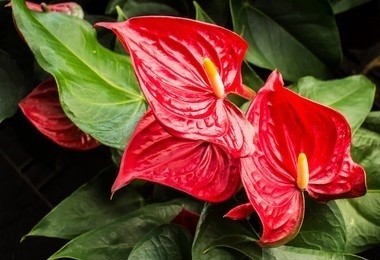Anthurium Plant Tissue Culture
Anthurium ornamental plants are the best of the Araceae family of ornamental plants, native to Central and South America tropical rainforests, like warm, humid, shady, and well-drained environment, with a constant flowering habit, each leaf axil produces a flower, flowering period from spring to autumn, in the greenhouse can be annual flowering, bracts unique shape, color, and bright green leaves, that is, the flowers and foliage can be appreciated, mainly used as fresh cut flowers, but also suitable for potted for indoor ornamental, is an important high-end ornamental flower.
 Anthurium is a red heart-shaped flower
Anthurium is a red heart-shaped flower
Using the tissue culture method we offer, a large number
of consistently growing, disease-free seedlings can be
obtained in a relatively short period of time.
Common cultivars
A. andraeanum has heart-shaped or oblong, dark green, leathery and glossy leaves, slender and stiff petioles, waxy, bright red and glossy flower buds, tough pedicels, constant flowering all year round, long flowering period, cut flowers can last up to 1 month in water, and curly fleshy inflorescences, which are mainly planted as potted flowers.
- Anthurium crystallinum(A. crystallinum and A.
warocqueanunare both ornamental parts of the leaves)
A. crystallinum is a dwarf and delicate plant. The leaves are broad-oval, purple at first, then velvety turquoise, with silvery-white veins woven into beautiful patterns on the leaves, making them a good decoration for the table.
A. warocqueanun leaves are large, upright, and upward, with long oval, bright green leaves, which is a good material for decorating halls and aisles and softening the sight.
In vitro culture and rapid propagation service
Anthurium was first propagated traditionally by seed and division, but with the commercial production of flowering candles worldwide, the traditional propagation methods no longer meet commercial production needs. Lifeasible has established an ex vivo culture technique to resolve this contradiction and promote the commercial production of Anthurium plants.
- Direct pathway to sterile seedlings from stem tips
Anthurium varieties differ greatly in their ability to regenerate in vitro among each other, and stem tip culture can directly obtain sterile seedlings without the process of dedifferentiation and re-differentiation, which not only can reduce the occurrence of variation during dedifferentiation, but also can obtain sterile systems of less-differentiable varieties.
- Healing tissue and adventitious shoot regeneration pathway
Explant type
Medium composition
Physical factors
Indeterminate shoot differentiation
- Direct regeneration pathway of indeterminate buds
We can obtain complete regenerated plants of Anthurium by the direct regeneration of indeterminate buds' route using leaves as explants. The type and concentration of growth regulators used, the developmental stage of the leaf explants, and the pH value had significant effects on the direct regeneration of indeterminate shoots.
- Somatic embryogenesis pathway
Obtaining complete plants by somatic embryogenesis is the most promising route for in vitro fast reproduction. Compared with the organogenesis route, the somatic embryo has two polar structures of root and stem, can regenerate into complete plants at once, has more stable genetic properties, and is suitable for cultivation in bioreactors.
You want to sign a confidentiality agreement.
You have a specific plant species for your experimental needs.
You have a reliable and relevant cooperation project to discuss.
You are very interested in our project or have any questions.
You need an updated and detailed quotation.
For research or industrial use.

 Anthurium is a red heart-shaped flower
Anthurium is a red heart-shaped flower
